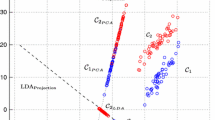Abstract
In this paper we propose three variants of a linear feature extraction technique based on Adaboost for two-class classification problems. Unlike other feature extraction techniques, we do not make any assumptions about the distribution of the data. At each boosting step we select from a pool of linear projections the one that minimizes the weighted error. We propose three different variants of the feature extraction algorithm, depending on the way the pool of individual projections is constructed. Using nine real and two artificial data sets of different original dimensionality and sample size we compare the performance of the three proposed techniques with three classical techniques for linear feature extraction: Fisher linear discriminant analysis (FLD), Nonparametric discriminant analysis (NDA) and a recently proposed feature extraction method for heteroscedastic data based on the Chernoff criterion. Our results show that for data sets of relatively low-original dimensionality FLD appears to be both the most accurate and the most economical feature extraction method (giving just one-dimension in the case of two classes). The techniques based on Adaboost fare better than the classical techniques for data sets of large original dimensionality.






Similar content being viewed by others
Notes
We assume that the reader is familiar with Adaboost although the feature extraction should be reproducible from the Fig. 3
Functions from the PRTOOLS 3.1.7 toolbox [24] have been used for classifiers 1–3. For the SVM classifier we used the OSU SVM Classifier Matlab toolbox 3.00 that can be downloaded from http://www.ece.osu.edu/∼maj/osu_svm/.
Full information about the standard deviations and the calculated confidence intervals can be found at http://www.cvc.uab.es/∼davidm/experiments.htm
References
Hyvarinen A, Karhunen J, Oja E (2001) Independent component analysis. John Wiley and Sons
Friedman JH (1987) Explanatory projection pursuit. J Am Statistical Assoc 82:249–266
Lee DD, Seung HS (1999) Learning the parts of objects with nonnegative matrix factorization. Nature 401:788–791
Fisher R (1936) The use of multiple measurements in taxonomic problems. Ann Eugenics 7:179–188
Fukunaga K, Mantock J (1983) Nonparametric discriminant analysis. IEEE T Pattern 5(6):671–678
Loog M, Duin RPW (2004) Linear dimensionality reduction via a heteroscedastic extension of lda: The Chernoff criterion. IEEE T Pattern Anal 26(6):732–739
McLachlan GJ (2004) Discriminant analysis and statistical pattern recognition. John Wiley and Sons, Inc, New York
RST, SLK (2000) Nonlinear dimensionality reduction by locally linear embedding. Science 290:2323–2326
Tenenbaum JB, de Silva V, Langford JC (2000) A global geometric framework for nonlinear dimensionality reduction. Science 290(5500):2319–2323
Long PM, Vega VB (2003) Boosting and microarray data. Machine Learning 52:31–44
Athitsos V, Alon J, Sclaroff S, Kollios G (2004) Boostmap: a method for efficient approximate similarity rankings. In: CVPR (2), 2004, pp 268–275
Sirlantzis K, Hoque S, Fairhurst MC (2002) Trainable multiple classifier schemes for handwritten character recognition. In: Multiple classifier systems, 2002, pp 169–178
Brown G, Yao X, Wyatt J, Wersing H, Sendhoff B (2002) Exploiting ensemble diversity for automatic feature extraction. In: Proc. of the 9th international conference on neural information processing (ICONIP’02), 2002, pp 1786–1790
Kuncheva LI (2004) Combining pattern classifiers. John Wiley and Sons
Breiman L (1998) Arcing classifiers. Ann Stat 26(3):801–849
Kirby M, Sirovich L (1990) Application of the Karhunen-Loeve procedure for the characterization of human faces. IEEE T Pattern Anal 12(1):103–108
Fukunaga K (1990) Introduction to statistical pattern recognition, 2nd edn. Academic Press, Boston
Bressan M, Vitria J (2003) Nonparametric discriminant analysis and nearest neighbor classification. Pattern Recogn Lett 24(15):2743–2749
Schapire RE (1999) A brief introduction to boosting. In: IJCAI, 1999, pp 1401–1406
Freund Y, Schapire RE (1996) Experiments with a new boosting algorithm. In: International conference on machine learning, 1996, pp 148–156
Blake C, Merz C (1998) UCI repository of machine learning databases http://www.ics.uci.edu/∼mlearn/MLRepository.html
Skurichina M (2001) Stabilizing weak classifiers, Ph.D. thesis, Delft University of Technology
Martinez A, Benavente R (1998) The AR face database. Tech Rep 24, Computer Vision Center (June 1998)
Duin RPW (2004) PRTOOLS v3.17, Tech. rep., Delft University of Technology. http://www.ph.tn.tudelft.nl/∼bob/PRTOOLS.html
Acknowledgements
This work is supported by MCYT grant TIC2003-00654, and FP2000-4960 Ministerio de Ciencia y Tecnologia, Spain.
Author information
Authors and Affiliations
Corresponding author
Rights and permissions
About this article
Cite this article
Masip, D., Kuncheva, L.I. & Vitrià, J. An ensemble-based method for linear feature extraction for two-class problems. Pattern Anal Applic 8, 227–237 (2005). https://doi.org/10.1007/s10044-005-0002-x
Received:
Accepted:
Published:
Issue Date:
DOI: https://doi.org/10.1007/s10044-005-0002-x




